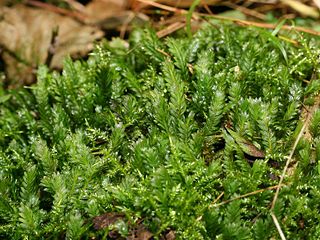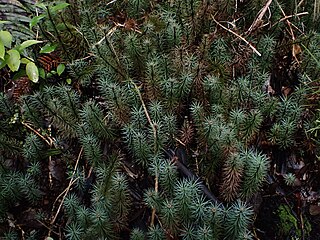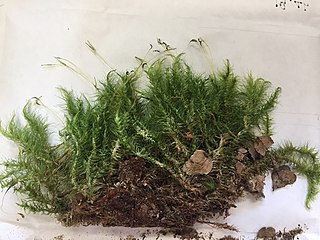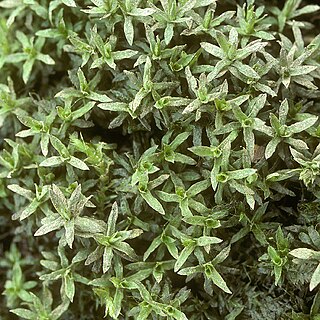
A sporangium ; pl.: sporangia) is an enclosure in which spores are formed. It can be composed of a single cell or can be multicellular. Virtually all plants, fungi, and many other lineages form sporangia at some point in their life cycle. Sporangia can produce spores by mitosis, but in nearly all land plants and many fungi, sporangia are the site of meiosis and produce genetically distinct haploid spores.

Fissidens adianthoides, the maidenhair pocketmoss, is a moss in the family Fissidentaceae. It was first collected by Hedwig in 1801.

Dawsonia superba is a moss in the family Polytrichaceae that is found in Australia, New Guinea, Malaysia and New Zealand. D. superba is the tallest self-supporting moss in the world, reaching heights of 60 cm (24 in). It has analogous structures to those in vascular plants that support large size, including hydroid and leptoid cells to conduct water and photosynthate, and lamellae that provide gas chambers for more efficient photosynthesis. D. superba is a member of the class Polytrichopsida, although it has a sporophyte that is unique from other hair-cap mosses.

Splachnaceae is a family of mosses, containing around 70 species in 6 genera. Around half of those species are entomophilous, using insects to disperse their spores, a characteristic found in no other seedless land plants.

Pogonatum urnigerum is a species of moss in the family Polytrichaceae, commonly called urn haircap. The name comes from "urna" meaning "urn" and "gerere" meaning "to bear" which is believed to be a reference made towards the plant's wide-mouthed capsule. It can be found on gravelly banks or similar habitats and can be identified by the blue tinge to the overall green colour. The stem of this moss is wine red and it has rhizoids that keep the moss anchored to substrates. It is an acrocarpous moss that grows vertically with an archegonium borne at the top of each fertilized female gametophyte shoot which develops an erect sporophyte.

Warnstorfia exannulata is a leafy branching wetland moss in the genus Warnstorfia within the family Amblystegiaceae and class Bryopsida. This bryopsida moss is also known as ringless-hook moss or Warnstorfia moss. It is the most common species of the genus in wetland environments and can be difficult to distinguish from others within the genus. It grows in acidic soils like fens and bogs, or in freshwater pools and lakes.

Climacium dendroides, also known as tree climacium moss, belongs in the order Hypnales and family Climaciaceae, in class Bryopsida and subclass Bryidae. It is identified as a "tree moss" due to its distinctive morphological features, and has four species identified across the Northern Hemisphere. The species name "dendroides" describes the tree-like morphology of the plant, and its genus name came from the structure of the perforations of peristome teeth. This plant was identified by Weber and Mohr in 1804. They often have stems that are around 2-10 cm tall and growing in the form of patches, looking like small palm-trees. They have yellow-green branches at the tip of stems. The leaves are around 2.5-3 mm long, with rounder stem leaves and pointier branch leaves. Their sporophytes are only abundant in late winter and early spring, and appears as a red-brown shoot with long stalk and cylindrical capsules.

Dicranoloma dicarpum is relatively common moss which is widespread in the Southern Hemisphere. The genus Dicranoloma has 40 species, which share the features of long stems, wispy and twisted leaves, and large, erect capsules. The genus is dominant in wet forest habitats in Australia and New Zealand.

Andreaea rothii, or Roth's andreaea moss, is a species of moss in the family Andreaeaceae native to North America and parts of Europe. This plant was described in 1807 by Weber and Mohr.

Warnstorfia fluitans, the floating hook-moss or water hook-moss, is a species of moss found in acidic habitats across all continents except Antarctica.

Andreaea rupestris is a species of moss in the class Andreaeopsida, are commonly referred to as the "lantern mosses" due to the appearance of their dehisced sporangia. It is typically found on smooth, acidic, exposed rock in the Northern hemisphere. It exhibits the common features of the genus Andreaea such as being acrocarpous, having dark pigmentation, lacking a seta, and bearing 4 lines of dehiscence in its mature sporangia, but can be further identified upon careful examination of its gametophytic leaves which have an ovate base to a more blunt apex compared to other similar species.

Tortula muralis, commonly known as wall-screw moss, is a species of moss in the family Pottiaceae. T. muralis is found throughout the world.

Syntrichia latifolia, formerly Tortula latifolia, and commonly known as water screw-moss, is a species of moss belonging to the family Pottiaceae. Syntrichia species differ from members of Tortula due to synapomorphic leaf qualities, such as different basal and distal cells, as well as different costal cross sections where Tortula has an abaxial epidermis and Syntrichia lacks one.

Polytrichastrum formosum, commonly known as the bank haircap moss, is a species of moss belonging to the family Polytrichaceae.

Sciurohypnum, or Sciuro-hypnum, is a genus of mosses belonging to the family Brachytheciaceae.

Andreaea nivalis, also known as snow rock-moss, is a species of moss in the Andreaea family found in Alaska, California, Oregon, Washington, Greenland, Spain, Japan, Russia and Poland. It is black and reddish, dioicous, and grows on wet, acidic rocks. It is threatened by droughts and global warming, and is a near-threatened species on the IUCN red list.
Andreaea blyttii, also commonly known as Blytt's rock moss, is a moss belonging to the family Andreaeaceae, commonly known as rock moss, granite moss, or lantern moss because of this family's unique sporangium. It is part of the genus Andreaea which is known for forming dark brownish or reddish-black carpets in high elevations. This species was first described by Schimper in 1855.

Timmia megapolitana, also known as Indian feather moss and warrior moss is a genus of moss in the family Timmiaceae and order Timmiales.

Callicladium imponens, also known as brocade moss, is a species of moss native to North America. It is usually golden to yellow-green coloured, sometimes brownish. Its stems are medium to large sized usually reaching 3–10 cm. Unlike some other moss species, C. imponens lacks a hyalodermis but possesses a weak central strand.

Sarmentypnum exannulatum, also known as ringless hook-moss, is a species of medium-sized wetland moss belonging to the family Amblystegiaceae. It was first described by Wilhelm Philipp Schimper in collaboration with his brother Wilhelm Philippe Schimper in 1854.



















